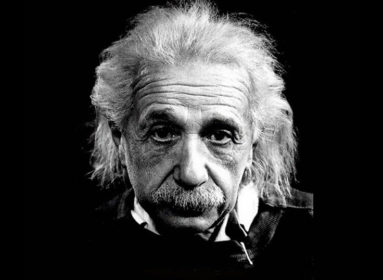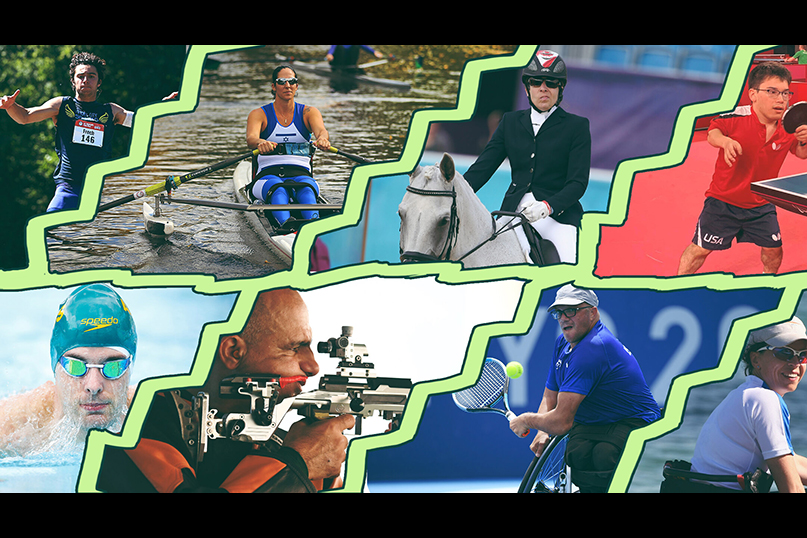
By Emily Burack
(JTA) — Weeks after the Olympics came to a close, Tokyo is filled again with athletes, for the 2020 Tokyo Paralympics. Among them are dozens of Jewish athletes looking to medal in an array of sports.
The Paralympics, founded by the late German-Jewish doctor Ludwig Guttman, are for athletes with physical disabilities. Some 4,500 athletes are set to compete in 539 events in the 16th Paralympics, which started Aug. 24 and will close September 5.
Team Israel is sending 33 athletes to compete in 11 sports. But there are notable competitors as well to watch from the United States, Australia and Canada. Here’s our guide to some of the Jewish para-athletes to watch.
Pascale Bercovitch: Canoe, Israel
Pascale Bercovitch is a French-Israeli writer and film director — and four-time Paralympian. Born in France, Berkovitch was set to make aliyah to Israel when, at 17, she slipped at a train station and fell under an incoming train.
“I was totally in shock, I tried to call for help and I lay on the rails for 47 minutes on my own, it was such a long time,” Bercovitch told Reuters. “I didn’t know what would happen … was I going to survive? … I understood that all I was and all I knew was gone and I didn’t know how my new life would be, if I even had prospects of a new life.”
The accident resulted in the amputation of both her legs above the knee. The change would inform her life’s work.
In 2000, Bercovitch made a documentary about the Israeli Paralympic swimming team in Sydney, “Three Hundredths of a Second.” Eight years later, she became a Paralympian on her own, competing as a rower at age 40 in Beijing. In London in 2012, she was a hand-cyclist. In Rio 2016, she competed in kayak in paracanoe. And in Tokyo 2020, she will be competing in her fourth Paralympics — for the first time sticking to one sport for two straight games.
Berkovitch, 54, splits her time among training, writing, motivational speaking and raising her two daughters.
“I understood that there was no other choice than to fulfill your dreams,” she told JTA in 2013. “Life can end in an instant. What’s important is to savor every moment. It didn’t matter how.”
Ezra Frech: Track and field, United States
At 16, Ezra Frech will be one of the youngest athletes to represent Team USA this year, competing in the amputee classification for the high jump, long jump and the 100 meters.
Due to a congenital abnormality, the Los Angeles was born with only one finger on his left hand and missing his left knee and shinbone. At two he had surgery to remove the curved part of his leg, and had a toe attached to his left hand. By nine he was advocating for adaptive sports on “Ellen,” and at the 2019 World Para Athletics Championships, at 14, he was the youngest competitor.
Frech’s mom, Bahar Soomekh, is a Persian-Jewish actress who fled Iran with her family in 1979. His dad, Clayton, left his job in 2013 to found Angel City Sports — to bring adaptive sports opportunities to Los Angeles.
“Everywhere you go, people don’t think you’re capable of what an able-bodied person can do,” Ezra Frech said earlier this year. “I’ll go to my high school track meet and they don’t expect the one-legged kid to go out and win the competition. When I was younger it got to me, but now it’s a motivation and excites me that I have a chance to prove people wrong, to shock them and turn some heads.”
Tahl Leibovitz: Table tennis, United States
Tahl Leibovitz was struggling with homelessness when he participated in a table tennis program for at-risk youth at the South Queens Boys and Girls Club in his hometown of New York City. In 1995, he learned his osteochondroma — overgrowth of cartilage and bone, characterized by sometimes-painful noncancerous bone tumors — qualified him for the Paralympic Games, and he made his debut the following year in Atlanta — where he won gold.
When not competing in para table tennis, Leibovitz works as a social worker and a coach at PingPod in New York. He launched a GoFundMe to help him pay for his travel to Tokyo. “I have greatly diminished my work so that I am able to pursue my dream of once again standing on the medal stand with the Team USA flag raised!” he wrote.
Leibovitz, now 46, is competing in his sixth Paralympics and has picked up two bronze medals since his debut.
“I think this will be the best ever,” he said in a Team USA news release. “I am looking forward to an amazing experience with my teammates.”
Matthew Levy: Swimming, Australia
Matthew Levy is returning to compete in his fifth Paralympics. The Australian Jewish swimmer, 34, competes in the freestyle, butterfly and medley races.
Born premature at 25 weeks with cerebral palsy and vision impairment, Levy started swimming at five as part of his rehabilitation following surgeries. At 12, he realized he could swim competitively, and he made his Paralympic debut in Athens in 2004. At the 2008 Beijing Games, Levy won his first medal — gold in the 4x100m medley. He won five more (a gold, a silver and three bronze) in London in 2012, and another bronze in 2016 in Rio de Janeiro. He’s looking to add to his medal count in Tokyo as the oldest member of the Australian Paralympic swimming team.
In 2014, Levy was awarded a Medal of the Order of Australia for his contributions to sport. And in 2017, Levy became the first person in its history to break a world record while competing in the Maccabiah Games, an international Jewish sports competition.
Ariel and Mark Malyar: Swimming, Israel
Ariel and Mark Malyar, 21-year-old twins, will be competing for Team Israel in Tokyo in their first Paralympics. Born with cerebral palsy, the brothers started swimming at age five as physical therapy.
“When we were younger there was a lot of competition between us, but now, not so much,” Mark Malyar said.
Mark set a world record at the 2019 World Para Swimming Championships in the men’s 400m freestyle S7 class.
Moran Samuel: Rowing, Israel
Moran Samuel won a Paralympic medal at the 2016 games in Rio, taking bronze in the women’s 1,000-meter single sculls rowing competition.
Samuel, 39, grew up playing basketball and was a member of the Israeli women’s national team. But in 2006, at 24, she suffered a spinal stroke and was paralyzed in her lower body. She started playing wheelchair basketball, then decided to try rowing to get to the Paralympic Games. Her two biggest dreams were becoming a mother and winning an Olympic medal — and now she’s achieved both.
“If you want to be a very successful woman, you should have a woman by your side,” she once joked. With wife Limor Goldberg, she’s now a mom of two. And in Tokyo, at her third Paralympic Games, she’s going for gold.
Samuel was one of two flag bearers for Israel in the games’ opening ceremony Tuesday, along with boccia player Nadav Levi.
Jody Schloss: Equestrian, Canada
Jody Schloss grew up in Edmonton, Alberta, where she attended a Jewish day school, then rowed competitively at the University of British Columbia. (She has Jewish-Canadian pioneers on both sides of her family, according to a Canadian Jewish magazine.)
But at 23, she was in a car accident in California that killed her friend, put her in a five-month coma and ultimately left her unable to walk and with a speech disability. She had ridden horses since age 11 and turned to equestrian sports as part of her recovery. Now 48, Schloss is competing in her second Paralympics, after an 11th-place showing in London in 2012. She’ll be riding a new horse after her longtime horse Rebus had to be treated with a medication that is banned from competition.
“Rebus was really angry that he wasn’t going,” Schloss told the Globe and Mail. “Lobin said he was excited, but I don’t think he knew how far he was going.”
Ian Seidenfeld: Table tennis, United States
Ian Seidenfeld is a first-timer at the Paralympic Games. His dad, Mitch, is a table tennis Paralympian himself who competed in Barcelona in 1992, Atlanta in 1996 and in Beijing 2008, winning a total of four medals, including one gold. Mitch Seidenfeld has since transitioned into coaching, and served as a coach for Leibovitz, but now coaches his son.
Both Seidenfelds have Pseudoachondroplasia dwarfism, an inherited bone growth disorder. Ian started playing when he was six and began competing at the international level when he was 12.
“Being compared to my dad, to be close to his level, would make me very happy,” the younger Seidenfeld told the Minneapolis Star-Tribune, his hometown newspaper. “The Paralympics has always been a goal, and my dad has always been very supportive of me. But I didn’t think it would happen this soon. … I never like to say I’m confident, but I’m going to do my best.”
Doron Shaziri: Shooting, Israel
Doron Shaziri is set to compete in his eighth consecutive Paralympic Games — he’s won medals at six of them. The 54-year-old Israel marksman is aiming for his first gold.
Shaziri lost his leg at 19 when he stepped on a mine while on patrol in Lebanon in 1987 with the Israeli army, serving as a sniper. While at Beit Halochem in Tel Aviv, a rehabilitation center for disabled veterans, he discovered a passion for sport shooting.
“Shooting is a very mental sport and if you succeed it means you are mentally strong. That is the skill I work on most because I already have the technical skills,” Shaziri told Israeli media. “Unlike other sports, in shooting you should keep your adrenaline down because a high pulse is bad for stability. It’s not like running faster or hitting stronger. You have to go calmer.”
When not competing in Paralympic shooting, Sharizi builds custom wheelchairs for athletes.
Shraga Weinberg: Wheelchair tennis, Israel
Shraga Weinberg, considered one of the best wheelchair tennis players in the world, is set to compete in his fifth Paralympics, aiming for his third medal. He won silver in the mixed doubles in Beijing in 2008 and bronze in the quad doubles in London in 2012. At Rio in 2016, he served as the flag bearer for Team Israel.
Weinberg, 55, has quadriplegia as the result of a spinal cord injury.
“A disability is just something exterior,” Weinberg told the Israeli media. “The way that you see your disability is the same way the public will see it. If you don’t see your disability as an obstacle, society won’t either.”
Israeli Paralympic swimmer Mark Malyar wins gold medal and sets a new world record
By Emily Burack
In his first Paralympic Games, 21-year-old Israeli swimmer Mark Malyar has made history: He won gold for Team Israel and set a new world record in the men’s 200-meter individual medley (SM7) category.
Malyar swam the race in a time of 2:29.01. The SM7 category includes swimmers who have limited leg function, or are missing a leg — which includes athletes with cerebral palsy and athletes with amputations.
Malyar’s gold is the second for Israel at this year’s Paralympics; on the first day of the competition, Israeli-Arab swimmer Iyad Shalabi won gold in the 100-meter backstroke (S1 divison).
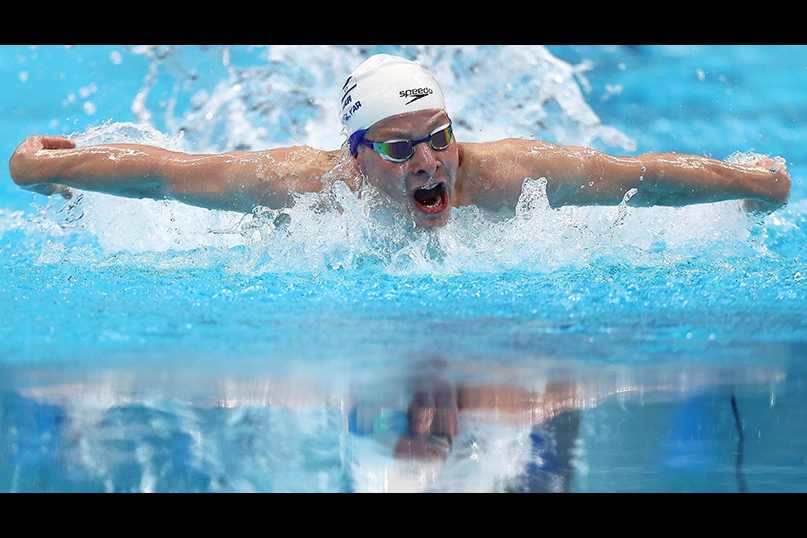
Mark Malyar is competing in Tokyo with his twin brother Ariel. Both were born with cerebral palsy and grew up in Kiryat Motzkin, in the Haifa District. They started swimming at age 5 for physical therapy.
President Isaac Herzog called Malyar to congratulate him on his win, saying, “Mark, this is so exciting. You are unstoppable. Both a gold medal and a Made-in-Israel world record! I wish you, your brother, and your special coach Yaakov Beininson more medals over the course of the games. Well done!”
Malyar’s Tokyo Games are not over yet: On Sunday, he competes in the 400-meter freestyle (S7), a race in which he holds the world record.
The Israeli twins are two of many inspiring Jewish athletes competing in this year’s Paralympics.
Israeli-Arab swimmer wins gold at Tokyo Paralympics, makes history
(JTA) — On the first day of the Paralympic Games in Tokyo, swimmer Iyad Shalabi made history: He became the first Israeli-Arab athlete to win a medal in the Olympics or Paralympics. Shalabi, 34, won gold Tuesday in the 100-meter backstroke in the S1 division in a time of 2 minutes, 28 seconds. Paralympic sports have a wide range of classifications; S1 denotes severe activity limitations. “My heart was pounding,” Shalabi’s father, Yusuf Shelby, told the Israeli media. “When he overtook his competitor, I cried. He was constantly training. Six years every day he trains. It’s like a dream.”
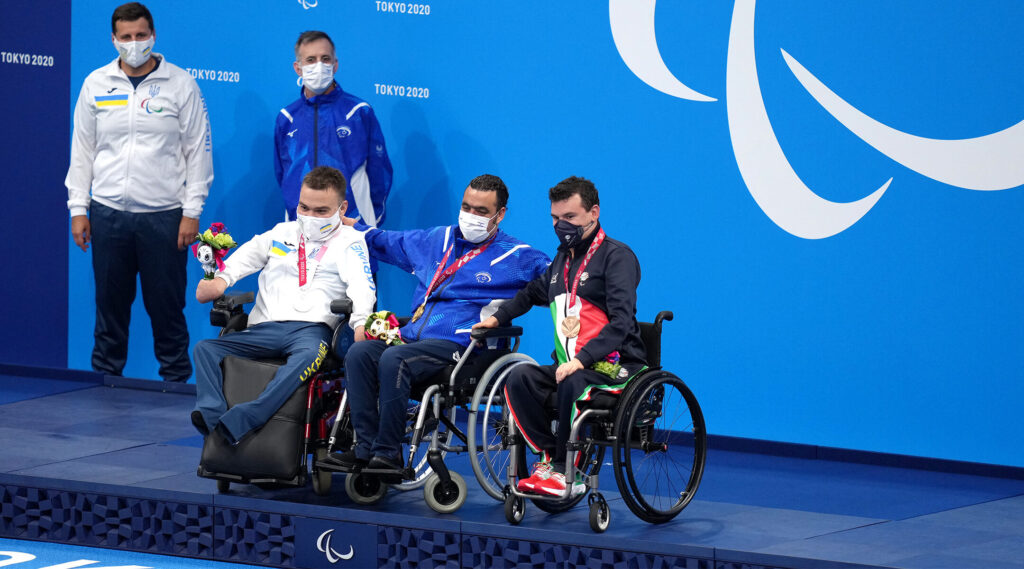
Shalabi was born deaf to a Muslim family in Shfar’am, in northern Israel. At age 12 he was paralyzed in an accident falling from a rooftop and lost the full use of his limbs. He competed in the Beijing and London Paralympics but failed to medal. A 2017 short documentary “Swimming Against the Current,” directed by Assel Abu Hjoul, documented Shalabi’s path to the World Championships in Scotland. The documentary premiered at the 2017 Jerusalem Film Festival. “Iyad is an inspiring man whose life is full of victories, and today he delivered another brilliant victory,” Israeli Culture and Sports Minister Hili Tropper wrote. “Iyad was not frightened by the high expectations and filled us all with great pride.”
The Jewish doctor who escaped the Nazis and founded the Paralympics
By Evelyn Frick
The 2020 Tokyo Paralympic Games opened on August 24. Unlike the Olympic Games, the Paralympics have an inspiring Jewish origin story — thanks to its founder, Ludwig Guttmann.
Guttmann was born on July 3, 1899, in Tost, Germany (now Toszek, Poland), to a German-Jewish family. In 1917, while working as a volunteer at a hospital for coal miners, Guttmann encountered a patient with a spinal injury and paraplegia. At the time, paraplegia was effectively a death sentence; unfortunately this proved true for the young coal miner. However, the memory of this patient had a deep impact on Guttmann.
Just a year later, Guttmann began training in medicine at the University of Breslau before transferring to the University of Freiburg in 1919, where he graduated with his medical degree in 1924. At Freiburg, Guttmann became an active member of a Jewish fraternity that tried to stop the spread of antisemitism in universities. Eventually the fraternity also became a center for physical activity and fitness, so that “nobody needed to be ashamed of being a Jew.”
By the 1930s, Guttmann was working as a neurosurgeon at the Wenzel Hancke hospital in Breslau (now Wrocław, Poland), as a university lecturer and as an assistant to Otfrid Foerster, a pioneer of neurosurgery. Guttmann was on track to be the next big German neurologist — until the rise of the Nazis in his country. In 1933, Germany passed the Nuremberg Laws, which among its other antisemitic stipulations prohibited Jews from practicing medicine. Guttmann was expelled from his university appointment, fired from his hospital job and stripped of his doctor title. He was assigned to work at the Breslau Jewish Hospital.
Not long after came Kristallnacht.
“On the 9th of November I took my car and went to the synagogue,” Guttmann remembered later. “And there, the whole thing was surrounded by hundreds of people, burning, and SS men playing football with prayer books. I stood there and realized that my tears were running down. But I became quite determined to help persecuted people.”
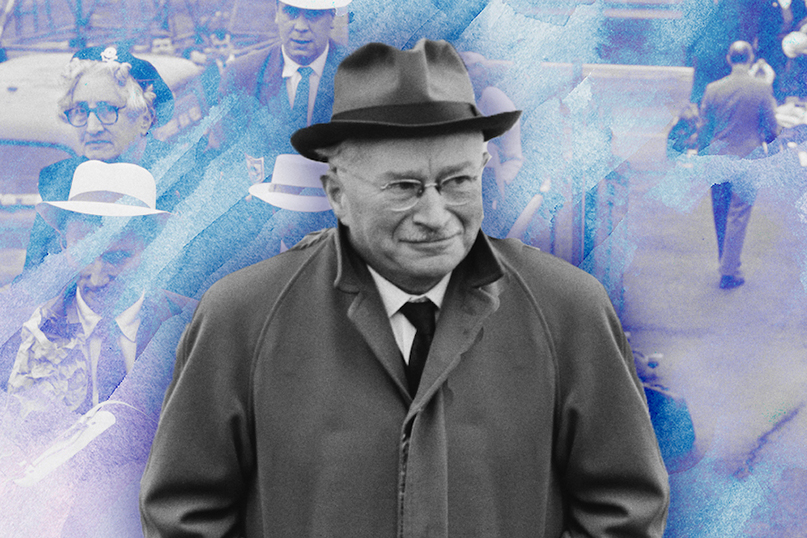
That evening, 64 people came to the hospital seeking refuge from the pogrom and the Gestapo. Guttmann admitted them all. The next morning he was called down to the hospital by the SS.
“I went to the hospital and there were three SS officers sitting there,” Guttmann recounted. “‘Sixty-four people were admitted. How can you explain this?’ I discussed every case, and of course I invented all kinds of diagnoses, you see. Out of the 64 people, I saved 60.”
By 1939, avenues of escape were quickly closing, but Guttmann was given a rare opportunity: The Nazis reinstated his passport and ordered him to travel to Portugal to treat a friend of the Portuguese dictator. With his family in tow, Guttmann traveled there, with his return trip to Germany scheduled through England. The Council for Assisting Refugee Academics anticipated his arrival and arranged for Guttmann and his family to stay in the United Kingdom. On March 14, 1939, the family arrived in Oxford, and in 1945 Guttmann became a naturalized citizen of the UK.
In England, Dr. Guttmann was able to continue his spinal injury research at the Radcliffe Infirmary, and later was asked to establish and direct the Spinal Injuries Centre at the Stoke Mandeville Hospital. Not only was the center revolutionary as the first specialist unit in the United Kingdom for spinal injuries, but it’s also where Guttmann pioneered treatment and rehabilitation for tetraplegic and paraplegic patients. At the time, the mortality rate of paralyzed patients was still incredibly high due to infections caused by bed sores. Guttmann’s answer was to turn patients on their sides every two hours to prevent bed sores. Through this treatment, patients with paraplegia lived.
The next step was creating rehabilitation programs that would allow paraplegic patients to build their self-esteem.
“It occurred to me that it would have been a serious omission not to include sport in the rehabilitation of handicapped people,” he said. “That was probably one of the best thoughts I have ever had as a medical man.”
On July 29, 1948, the first Stoke Mandeville Games began on the same day as the opening for the London Summer Olympics. The games consisted of disabled war veterans, all of whom were in wheelchairs, competing in archery. The event was held annually and, in 1952, a team of paraplegic Dutch servicemen traveled to England to compete in the first international Stoke Mandeville Games.
In 1960, for the first time, the International Stoke Mandeville Games were held in Rome, Italy, alongside the Olympic Games. These games are now recognized as the first Paralympic Games. (The term “Paralympics” refers to the fact that they are parallel to the Olympics and was retroactively recognized by the International Olympic Committee in 1984.) The Rome event featured 400 athletes, representing 23 countries, with an array of disabilities. After 1960, the Paralympics were held every four years. The first Winter Games were in 1976.
The incredible growth of the Paralympic Games over such a short period of time was not without challenges, however. In 1968, the Olympic host city, Mexico City, backed out of hosting the Paralympic Games. Guttmann accepted an invitation from the Israeli government to hold them near Tel Aviv. That year, a crowd of nearly 10,000 watched the opening ceremonies at the stadium of Hebrew University in Jerusalem.
The Paralympics had to change venues again in 1980 when the Soviet Union refused to host them alongside the Moscow Olympics. Notably, when questioned about the refusal, a Soviet official told a journalist that there were no disabled people in the entire Soviet Union. So the Paralympics were held that year in Arnhem, Netherlands. Since the 1988 Summer Games in Seoul and the 1992 Winter Games in Albertville, France, the Paralympics and the Olympics have been held in the same cities and venues.
Guttmann founded the International Medical Society of Paraplegia (now the International Spinal Cord Society),and the British Sports Association for the Disabled (now the English Federation of Disability Sport). He also was a longstanding member of the Association for Jewish Refugees. He was appointed Commander of the Order of the British Empire and knighted by Queen Elizabeth II in 1966.
Guttmann died on March 18, 1980, but his legacy lives on. His work surpassed the Nazi eugenics that tried to eradicate him along with the Jewish and disabled communities.
This article originally appeared on Alma.
Main Photo: Jewish Paralympic athletes competing in 2021, (l to r) top, Ezra Frech, Moran Samuel, Jody Schloss, Ian Seidenfeld; bottom: Matthew Levy, Doron Shaziri, Shraga Weinberg, Pascale Bercovitch. (Graphic by Emily Burack; photos via Getty, except top right via Team USA)







 Southern New England Jewish Ledger
Southern New England Jewish Ledger